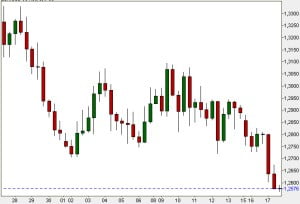
Trendline is one of the most easiest to understand technical indicators. Most of the charting software will automatically draw the trend line for you. You can use a bullish trendline and the bullish candlestick patterns to pick long entry points as well as confirm trends. In the same manner, you can use a bearish trendline in conjunction with bearish candlestick patterns for a short entry in the market.
When you combine a bullish trendline with a bullish candlestick pattern or a bearish trendline with a bearish candlestick pattern, you will get a pretty accurate signal that tells whether you should stick with a position or exit it.
For example there are bullish and bearish candlestick trending patterns like the bullish or bearish neck line pattern, bullish or bearish thrusting line pattern, bullish or bearish meeting line pattern etc that confirm the continuation of a trend. When you spot these candlestick patterns appearing above or below the trendline, you can safely continue with the long or short trade that you have initiated.
In the same manner when you find a bullish or bearish candlestick trend reversal pattern like the bullish or bearish three inside up pattern, bullish or bearish three outside up pattern etc appearing above or below a trendline, take it as a signal that the trend is about to reverse itself and this is the time to exit your trade.
You can also use trend lines and candlestick patterns to decide when to exit your position plus decide on the position of the stop loss. When you find price action to break a long established trendline, exit your position.
Now, you might be thinking how to use a trendline to define your exit stop level as it keeps on moving frequently. You will find the trend line changing daily on the chart. A good risk management strategy is to determine the support trendline in an uptrend or a resistance trendline in a downtrend and place an appropriate stop that is good for the day.
A second method is to exit a trade when the closing price is below the bullish trendline or above the bearish trend line. This can keep you from having to replace the stops daily and also keep you in a trade if the price takes a slight dive during the day before it retraces. This provides a certain flexibility so that you don’t have to see the trend continuing in the same direction after stopping you out of the market.
However, the price can dive and close much lower or higher than the trend line at the end of the day making your exit much lower or higher than if you had used a stop loss. It is up to you to decide which method fits your trading strategy and style best.
Related Reading
- Combining Moving Averages With Candlestick Patterns
- The Morning Star And The Three White Soldiers Candlestick Patterns
- Harami – An Important Trend Reversal Candlestick Pattern
- Trading Price Oscillator Divergences Can Increase Your Chances Of Making Winning Trades
- Bullish and Bearish Engulfing Candlestick Patterns Warn Of A Trend Reversal